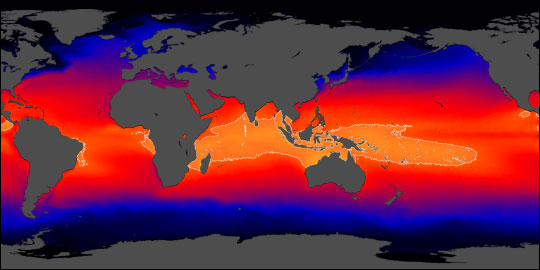New Concerns about Rising Sea Levels

Sea levels are rising in parts of the Indian Ocean, including the coastlines of the Bay of Bengal, the Arabian Sea, Sri Lanka, Sumatra and Java. And these changes appear to be at least partly a result of human-induced increases of atmospheric greenhouse gases, says a study led by the University of Colorado at Boulder.
The study combined sea surface measurements going back to the 1960s with recent satellite observations. It shows that the warming of the global climate appears to be raising sea levels in parts of the Indian Ocean, threatening inhabitants of some coastal areas and islands, and aggravating monsoon flooding in Bangladesh and India. This could have far-reaching impacts on both future regional and global climate, according to Professor Weiqing Han, who led the study.
At the heart of the rising ocean is the Indo-Pacific warm pool, an enormous, bathtub-shaped area of tropical ocean stretching from the east coast of Africa to the International Date Line in the Pacific. The temperature of this warm pool has risen by about 1 degree Fahrenheit in the past 50 years. Dr. Han said that the primary cause is human-generated increases of greenhouse gases.
If this trend continues – and there’s no indication that it won’t – then mid-ocean islands such as the Mascarenhas Archipelago, the coasts of Indonesia, Sumatra and the north Indian Ocean may soon find themselves under water.
Sea levels don’t rise uniformly all over the globe. In fact, there are certain regions where they’re falling, including around the Seychelles Islands and Zanzibar.
“Our new results show that human-caused changes of atmospheric and oceanic circulation over the Indian Ocean region — which have not been studied previously — are the major cause for the regional variability of sea level change,” wrote the authors of the study in Nature Geoscience.
One place where people have been extra worried is the Maldives group of islands in the Indian Ocean. Here, the study showed that when based on all-season data records, there is no significant sea level rise around the Maldives. But when the team looked at winter season data only, the Maldives show significant sea level rise, which is a cause for concern. The Maldives is made up of more than 1,000 islands — about 200 of which are inhabited by about 300,000 people — and are on average only about 5 feet above sea level.
